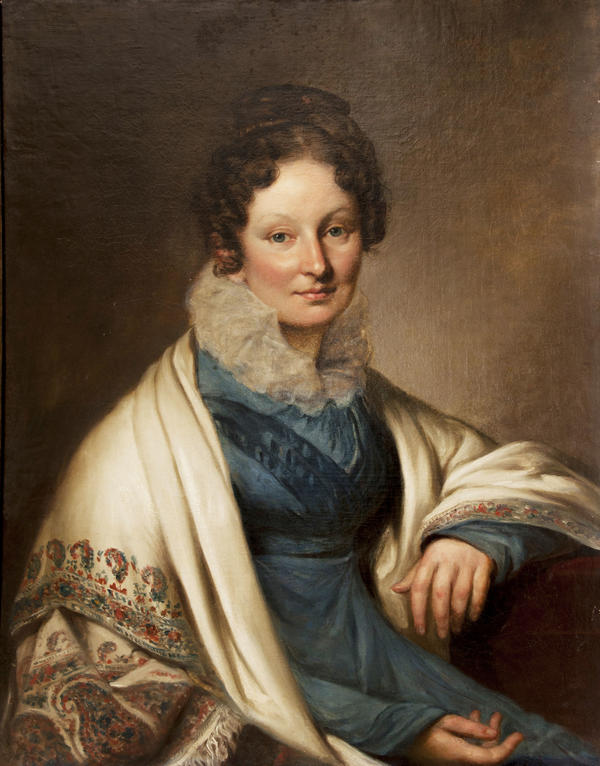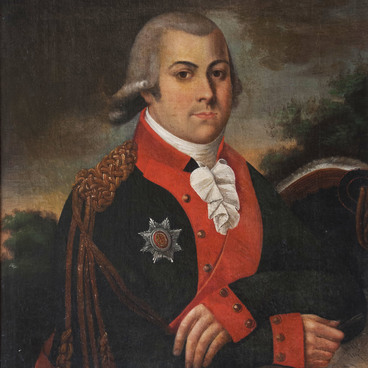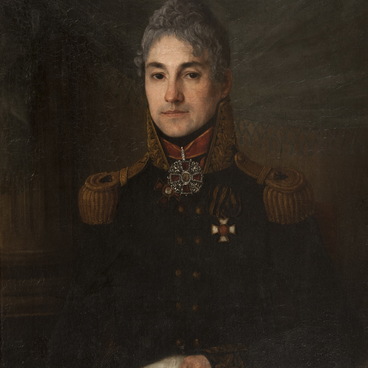The portrait of Sophia Boratynskaya, the wife of Russian Rear Admiral Ilya Boratynsky, was painted in the first half of the 19th century, before 1820. In the picture, she is 25 or older. She has a hairstyle, a shawl and a dress design, which are typical of a married woman.
The portrait of Sophia Boratynskaya, née Baryshnikova, is a chamber portrait, i. e., half-length and informal. Such portraits became increasingly popular in Russia in the late 18th and early 19th century, as well as the family gallery fashion. The artists used a neutral background, unlike in ceremonial portraiture where the environment emphasized the character’s status, noble origin and activity.
In the portrait, the artist focused on the character herself and her inner world: he painted her face with an open and confident look in much detail. Sophia Boratynskaya is sitting half-turned, with her elbow rested on the back of an armchair. She is wearing a day dress, dark blue, with a belt under her breast, and a large white ruche of starched cloth on her neck. Day dresses were designed for outings and receptions; they were formal, without short sleeves or cutouts. She casually flung a light coloured patterned shawl on her shoulders.
The Tambov Ethnography Museum acquired this portrait in 1919 together with other Boratynsky family portraits. At the close of the 19th century, the historian Mikhail Boratynsky left his family estate, Ilyinovka, and moved to Tambov with his wife and children. He also took the family portrait collection and some of the family records. After Yelizaveta Delvig, the last owner of the Boratynskies’ other family estate in the Tambov region, Mary, died in 1913, the museum acquired the remainder of the family’s portrait gallery.
On the top of the canvas stretcher, there is an old inscription: Sophia Ivanovna Boratynskaya. There is no signature of the author. Experts suppose that the portrait was painted by a professional portrait artist belonging to the painter Vasily Tropinin’s circle. Indirectly, this is suggested by the fact that Sophia’s father Ivan and brother Andrei were painted by Tropinin himself; he worked for the Baryshnikovs for more than 15 years.
The portrait of Sophia Boratynskaya, née Baryshnikova, is a chamber portrait, i. e., half-length and informal. Such portraits became increasingly popular in Russia in the late 18th and early 19th century, as well as the family gallery fashion. The artists used a neutral background, unlike in ceremonial portraiture where the environment emphasized the character’s status, noble origin and activity.
In the portrait, the artist focused on the character herself and her inner world: he painted her face with an open and confident look in much detail. Sophia Boratynskaya is sitting half-turned, with her elbow rested on the back of an armchair. She is wearing a day dress, dark blue, with a belt under her breast, and a large white ruche of starched cloth on her neck. Day dresses were designed for outings and receptions; they were formal, without short sleeves or cutouts. She casually flung a light coloured patterned shawl on her shoulders.
The Tambov Ethnography Museum acquired this portrait in 1919 together with other Boratynsky family portraits. At the close of the 19th century, the historian Mikhail Boratynsky left his family estate, Ilyinovka, and moved to Tambov with his wife and children. He also took the family portrait collection and some of the family records. After Yelizaveta Delvig, the last owner of the Boratynskies’ other family estate in the Tambov region, Mary, died in 1913, the museum acquired the remainder of the family’s portrait gallery.
On the top of the canvas stretcher, there is an old inscription: Sophia Ivanovna Boratynskaya. There is no signature of the author. Experts suppose that the portrait was painted by a professional portrait artist belonging to the painter Vasily Tropinin’s circle. Indirectly, this is suggested by the fact that Sophia’s father Ivan and brother Andrei were painted by Tropinin himself; he worked for the Baryshnikovs for more than 15 years.



